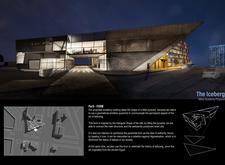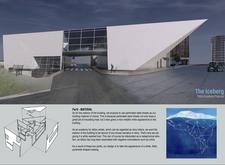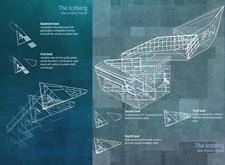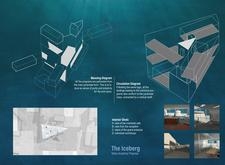5 key facts about this project
From a design perspective, the academy's architecture is characterized by a form resembling a tilted pyramid, a choice that conveys authority and stability while symbolizing a shift in societal views toward tattoos. The structure is designed to engage with its environment, inviting public interaction and demystifying the artistry involved in tattooing. The integration of public spaces at the ground level promotes accessibility, encouraging community members to participate in exhibitions and workshops, thus breaking down preconceived barriers.
Key components of the architectural design include strategically placed circulation paths that facilitate movement through the different levels of the building. The building includes a variety of spaces dedicated to different functions— the basement provides essential support services, while varied workshop areas on the upper levels are tailored for training emerging tattoo artists. Each level is designed to enhance collaboration, allowing for peer-to-peer learning and interaction among instructors and students.
Materiality plays a pivotal role in the architectural expression of the project. The use of perforated steel sheets as the primary exterior material not only offers a contemporary aesthetic but also contributes to the building's thermal efficiency. This material choice encapsulates the essence of the academy's mission, transforming not just how the building looks but also how it interacts with the environment. Glass elements are incorporated to ensure transparency, fostering a connection with the surrounding community and allowing natural light to permeate the interiors.
Unique design approaches are evident in the project’s overall layout and spatial organization. The inclined surfaces not only create visual interest but also encourage an exploration of the verticality within the structure. This thoughtful configuration helps to increase the engagement of visitors and students with the space, promoting a culture of openness and creativity.
In addition, the vertical circulation is designed to be not just functional but also a journey that enhances the user experience. With thoughtfully designated areas for relaxation and inspiration, the academy breaks from conventional educational environments by fostering a holistic approach to art and learning.
The overall architecture of the tattoo academy effectively communicates its purpose and significance, bridging the gap between a traditional craft and modern educational practices. This project serves as a testament to the evolving nature of tattoo artistry, reflecting a growing recognition of its complexity and cultural importance.
For those interested in gaining deeper insights into the architectural plans, sections, and innovative designs of this project, exploring the detailed presentation will provide valuable information on how the intersection of architecture and community engagement is envisioned within this academy.


























